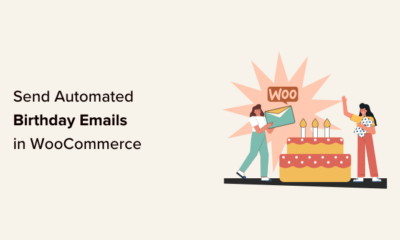EMAIL MARKETING
Why You Should Care About Email Testing
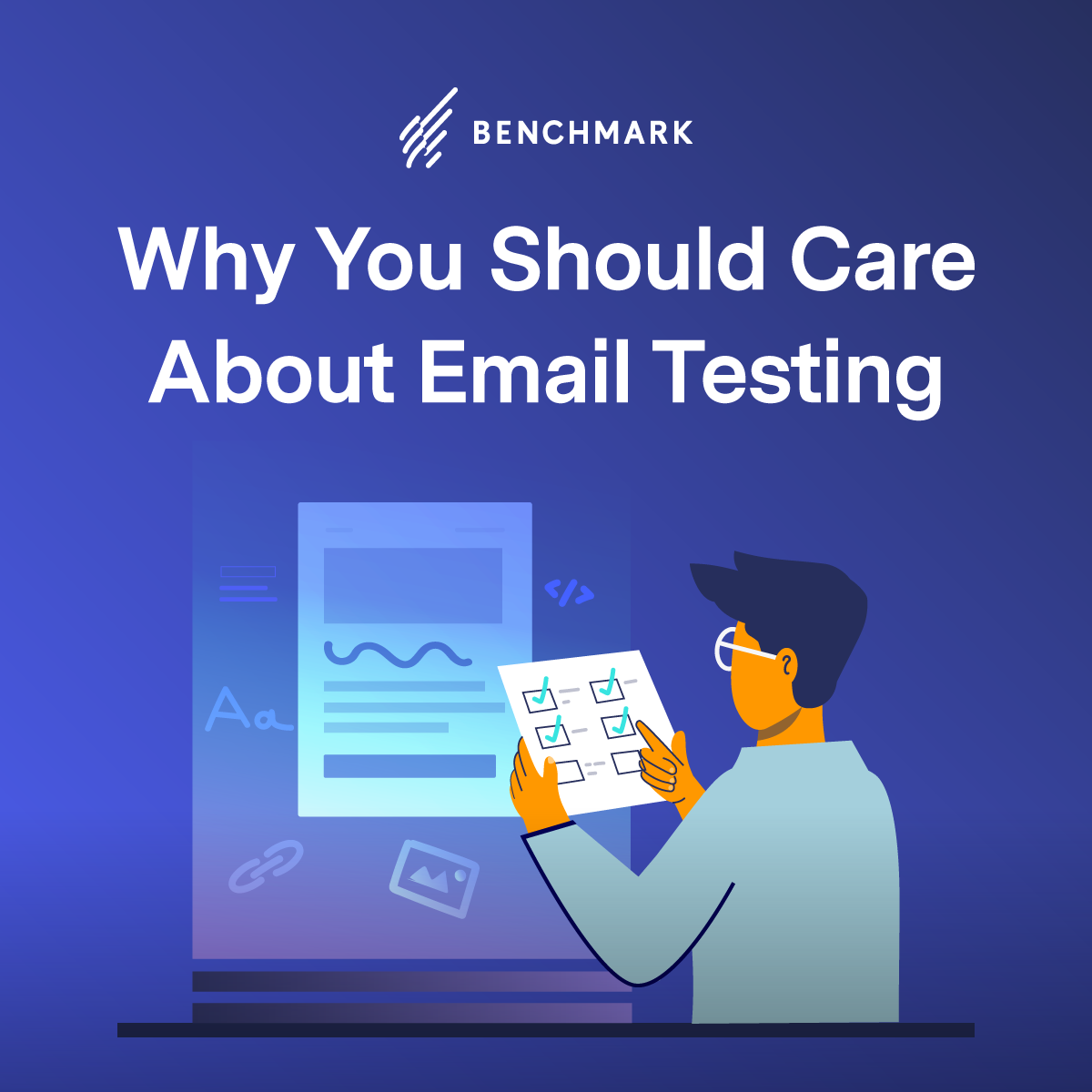
Most businesses still see email marketing as the most cost-beneficial and conversion-rich way to develop relationships with potential customers or clients and promote their products or services. What makes it such a powerful tool?
The numbers speak for themselves. A recent study holds that the median email marketing ROI is 122 percent. So far, no other digital marketing channel has proven to show such high results. Of course, the best way to boost your performance is to combine email marketing with social media or enable a live chat, which is statistically the fastest option to communicate with customers. But we’ll focus on improving email marketing efforts through email testing in this article.
When you run an email marketing campaign, creating emails that focus on your targeting audience and align with your marketing goals takes a lot of researching and strategizing. It’s a good idea for every email marketer to do email testing since it directly impacts the quality and deliverability of messages and indirectly ROI and subscribers retention.
Let’s take a closer look at email testing best practices.
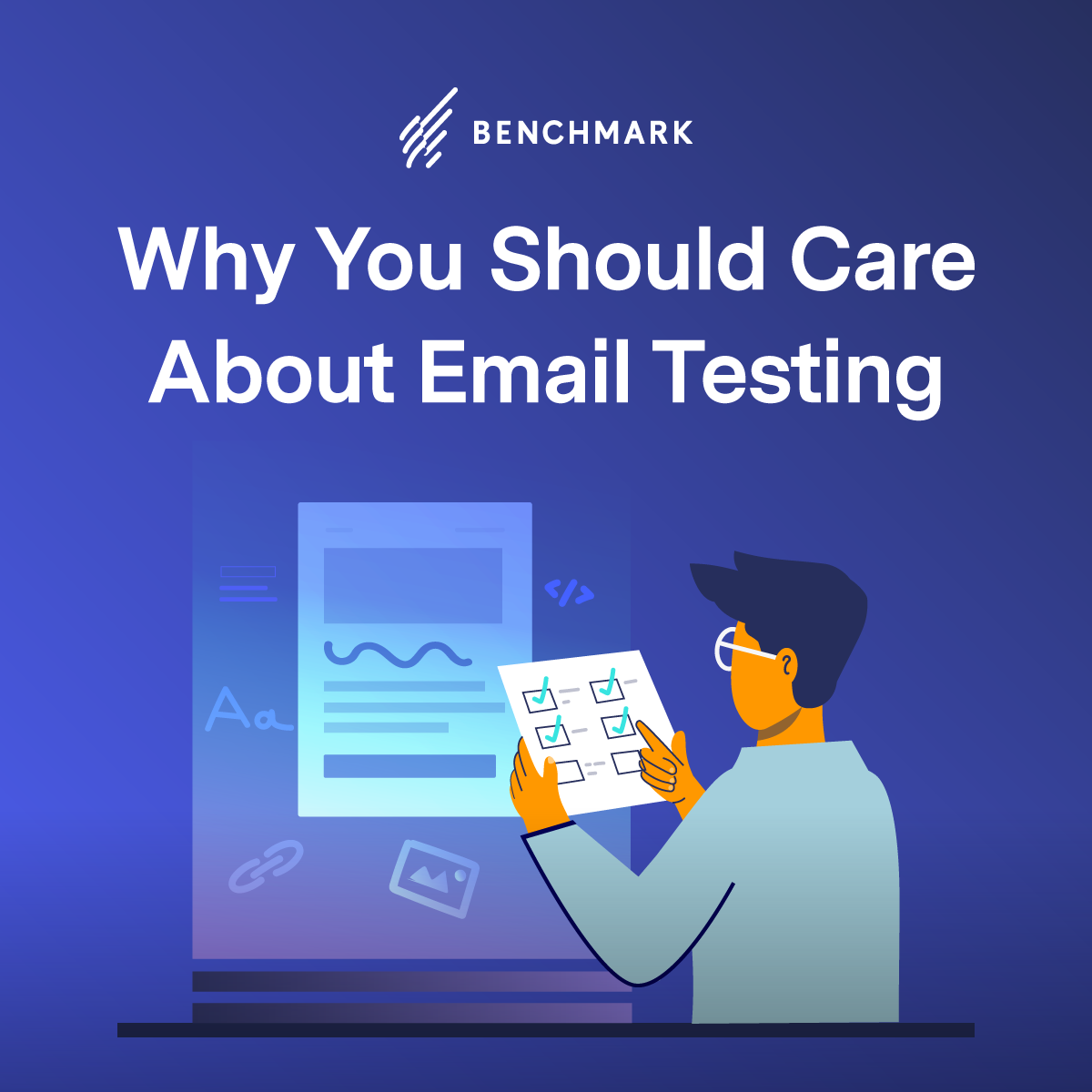
What is Email Testing?
Email testing allows you to view your email before sending it out to your subscriber list. Many email marketing services offer a way to preview the email in a web app or send a test email to yourself.
Testing your emails will help you fix broken email designs, incorrect or untracked links, choose a subject line with higher open rates, eliminate spelling and grammar errors, broken images or missing alt text, and more.
Let’s view seven elements that you should consider testing.
What Elements of My Emails Should I Test?
As we’ve mentioned above, you shouldn’t test more than one thing at a time to clearly see what’s really impacting your results. Choose one and measure against this metric in all your tests.
Subject Line
The subject line is crucial for your email campaign because this is what your recipients see first and decide whether they’re reading your message or not. You might have noticed that the subject line is formatted differently on most devices – it stands out due to email clients, display size, font difference, etc.
Your subject line should be catchy and interesting. At the same time, it shouldn’t sound spammy or violate email etiquette, failing which it will end up in the spam or junk folder.
- Bad Example: Here’s a FREE Newsletter with top articles! 🔥🔥🔥🔥🔥
- Good Example: John, February must-reads for you
Length of your subject line
Subject lines of 61 to 70 characters have the highest average read rate. However, the only way to determine the most compelling email subject line length for your campaign is to test it.
It’s a good idea to run an A/B test during every campaign and find out what subject line length gives better results.
Personalization
Personalized emails actually work. The recipient’s name included in the subject line can increase opens by over 18 percent, making it the most impactful word you can add to your subject line.
Try A/B testing it for your next email campaign. For example:
A: John, enjoy 50% off using this discount code
B: John, what about a great discount?
Microsegmentation is a good way to boost your personalization efforts. Try using a more diverse segmentation, experimenting with focused lists of users to deliver the most relevant content and offers.
Alternatively, you can try referencing the recipient’s previous orders, their company name, state, or choose other types of personalization.
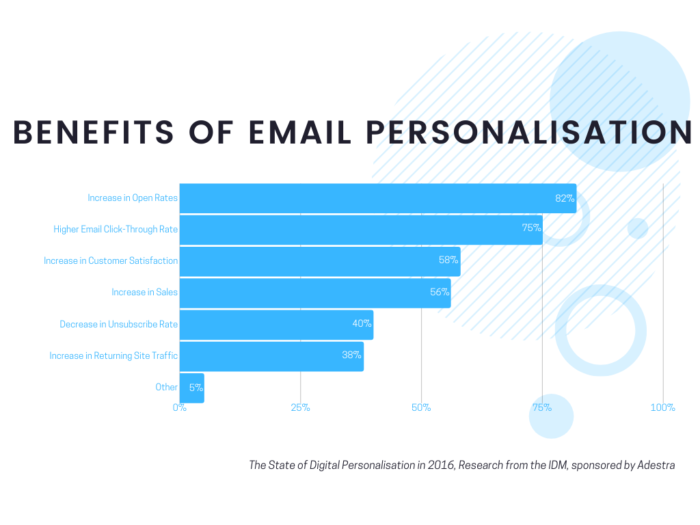
Source: Chamaileon
Content
Everyone is talking about the importance of quality content, but do you fully understand what content brings to your emails?
When you find out which content format works best for your newsletters and other emails, you will easily choose the resources for similar recipients in the future and use the most suitable email template.
Here’s what you can try linking out to in your messages:
- Case studies vs. Demo videos
- Blog articles vs. webinars
- PDFs vs. PowerPoint presentations
- Reports vs. Whitepapers
Media Elements
You can substantially increase your email performance by including the images, GIFs, videos, and other media elements that resonate with your recipients.
Before testing your emails, make sure you use similar alt and title text behind the media.
Some email clients don’t load media files, and in such cases, the alt and title text can make a big difference.
Keep the data in your test clear and avoid any changes in alt or title tags.
Here’s another option. When you run your test, start with placement or density and move on to image type or color.
If you have already experimented with images and GIFs, you should consider integrating video marketing in your email efforts as a solid way to increase brand awareness, improve sales, and increase customer engagement.
Day and Time
Be aware that you should run your day and time tests more than once. Some factors may keep your recipients offline: ISP slowdowns, holidays, or various unexpected events.
Before getting your final answer, try running your date and time test several times to make sure nothing impacts the data and your definitive answer.
Currently, due to the pandemic effect, user behavior has changed. As a result, such unpopular days to send marketing emails (Fridays and Saturdays) have become good alternatives to overused days (Tuesdays and Thursdays.)
When sending a newsletter, consider at least three day and time scenarios:
- Traditional: Tuesday or Thursday to be delivered at 1-3 PM
- Experimental: Wednesday to be delivered at 11-12 AM
- Extraordinary: Friday to be delivered at 9-11 AM or Saturday noon
Promotion and Special Offers
Nowadays, offering massive promotions several times a year is considered a new normal for generating customer interest. In fact, 91 percent of consumers are more likely to do business with brands that provide them with relevant, personalized offers and recommendations.
However, a popular promotion can end up costing a lot of money, while an offer that wins a lot of responses can bring you a considerable profit.
Keep in mind that some segments of your list may respond to one type of offer better than to a different kind of offer and promotion. There isn’t a “one size fits all” type of offer, and it’s a good idea to run a test with different propositions to different segments.
Once again, timing plays a central role here and may be crucial for the success of your offer.
Consider running an offer test several times, as you want to make it at a time when a product is popular and your audience is ready to spend money. Experiment with abandoned cart emails and re-engagement campaigns.
Tone
Is it possible to engage your recipient with just a tone? Psychologists say that by incorporating positivity into your message, you make it much easier for your reader to understand your message. This clear understanding, in its turn, increases their motivation to make a purchase or continue communication.
Think about your target reader and try to come up with a tone that would be friendly, positive, and informative at the same time. Do A/B testing of the email body to find which works best. It takes time, but it would definitely boost your click-throughs and purchases.
Tactics to try:
- Read aloud your message and ask a colleague for a check.
- Use bullet points and break the message into subsections.
- No big words are needed.
- Be simple, be friendly.
- Cause emotions.
- Ask questions (no more than three).
It’s important not to be gray in your emails. Don’t skip testing tones, polishing emails that will engage your audience best.
CTAs
A call-to-action in an email is a button, hyperlink of text, or dynamic QR codes that motivates the user to take the next step. You need to use strong call-to-action phrases to push your reader to click and proceed to your website before closing your email.
Additionally, CTAs have a great value for marketers, helping them evaluate their digital marketing campaigns’ effectiveness, analyze their target audience’s needs and preferences, and decide about the next step of the campaign.
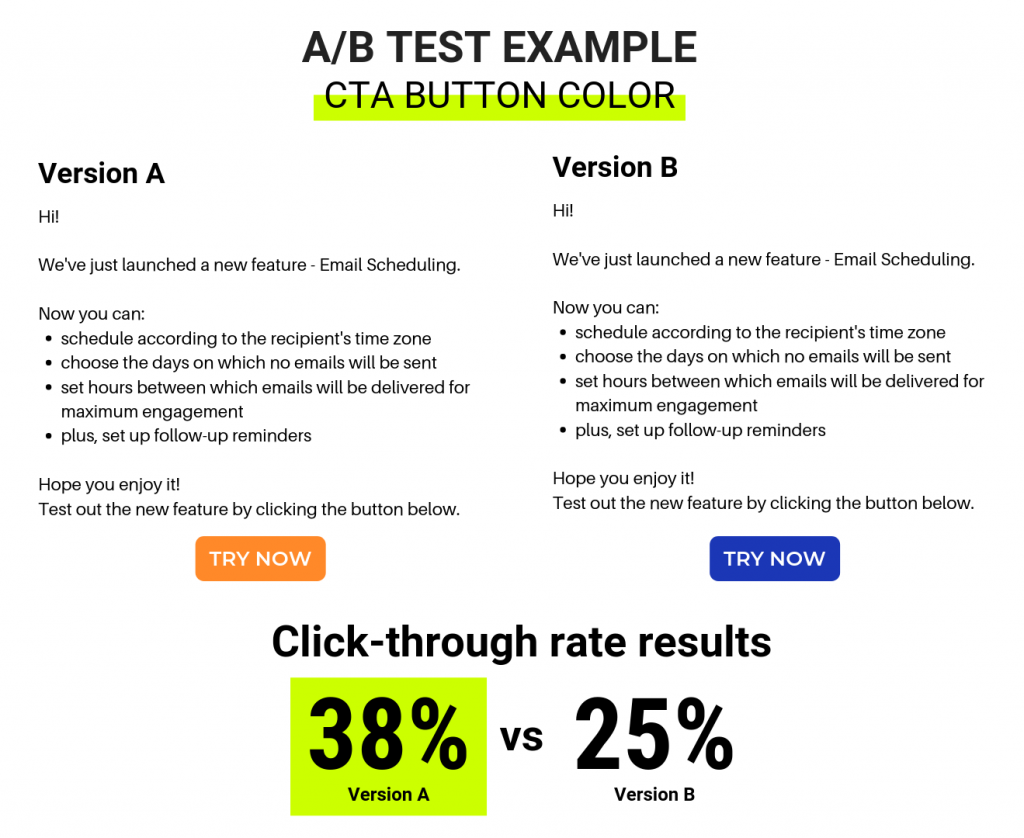
Source: Snov.io
How Should I Do All This Testing?
After the outlined practices you should definitely try in the next campaigns, a reasonable notion pops up: how to test all those elements. Fortunately, there’s a variety of tools and solutions that will assist you greatly.
Content Elements
- With all the A/B testing features, solid reporting, and the ability to preview your emails and make tweaks in content, consider choosing Benchmark Email.
- To improve the copy as well as the tone of your emails, feel free to use Grammarly or Hemingway.
- For evaluating and polishing subject lines, you can try out SubjectLine (we love a tool that’s straightforward in more ways than one).
Tech Elements
In this field, you definitely have to ensure your emails reach users, deal with spam rates, and do HTML checks. You can use all-in-one platforms for safe technical testing of your emails like Mailtrap or similar.
Alternatively, you can choose tools focusing on some aspects of such inspecting and debugging. For example, if you need to check spam rates only, there are tools like MailTester, or if you need to validate emails – EmailVerifier by Hunter will help.
At some point, you may need more tech-savvy tools for testing, say, API integration or configuring SMTP; feel free to check this email testing checklist article to know more.
When it comes to user-behavior aspects, like special offers and day/time testing, it requires a deep understanding of your audience and a bit of courage to experiment with it. So, to test these elements, constantly analyze and document the outcomes from previous campaigns.
6 Tips for Effective Email Testing
- Keep it simple. When testing your emails, it’s a nice idea to start with testing your subject lines. You don’t need a lot of time or creativity to contrive a few quick variants; however, this may give you a good return.
- Don’t test more than one element at a time. Remember, if you test several elements simultaneously, you may get confused over which variant worked out.
- Keep track of the time of day and day of the week. Send other variants on the same day and at the same time. This way, you will eliminate the timing variant.
- Keep a record of all tests you do. Leave the possibility to review the specific variables tested anytime you need to by always recording your findings.
- Test on a regular basis. If you decide to start testing your emails, make sure that email testing is a part of your daily routine.
- Make good conclusions and act wisely. Email testing will allow you to make decisions and modifications to your campaigns only if you analyze your findings and properly use what you learn.
Let’s Say it Again!
Email testing is an effective way to transfer your marketing effort into real results. Of course, the goal here isn’t to make your entire team focus on email testing but to get better results using the tips above and the tools below.
What do you start from? Understanding of your needs. Before running your first test, make sure you clearly understand what you’re doing it for and what results in your plan to generate from the process. And choose the correct solution.
Once you are set with your priorities, create a hypothesis. For example, “if we personalize our newsletter, our blog traffic will substantially increase.” You’ll need to determine the kinds of tests you’ll need to run to check whether your hypothesis works. Put together a timeline for easier scheduling, management, and organization of your testing process.
Author:
Dmytro Zaichenko is a Marketing Specialist at Mailtrap, an email sandbox service. He has over six years of experience in content creation. Apart from writing, he’s passionate about basketball and poetry.
EMAIL MARKETING
Unveiling the Future of Email Marketing: 4 Trends to Revolutionize Engagement

In today’s fast-paced digital landscape, the efficacy of email marketing hinges not only on the delivery of messages but also on their ability to resonate with audiences and drive meaningful interactions. Gone are the days of generic blasts; instead, companies are increasingly turning to innovative strategies to captivate their subscribers. Here, we delve into four emerging trends poised to redefine the realm of email marketing, promising to elevate engagement and drive conversions.
1. User-Generated Content (UGC) Takes Center Stage
User-generated content (UGC) emerges as a potent tool in the arsenal of email marketers, facilitating authentic connections with audiences while amplifying brand visibility. From customer reviews to social media posts, UGC offers a dynamic and relatable portrayal of products and services, resonating with consumers in the era of “new sincerity.”
By harnessing UGC within newsletters, brands gain invaluable insights into consumer preferences and behaviors, fostering trust and credibility. Strategies such as incentivized contests or social media challenges empower users to contribute content willingly, fueling a steady stream of authentic engagement.
2. Augmented and Virtual Realities (AR/VR) Transform Experiences
Augmented reality (AR) and virtual reality (VR) technologies emerge as game-changers in the realm of email marketing, offering immersive experiences that captivate and compel audiences. While VR may require substantial investments and specialized equipment, AR presents a more accessible avenue for brands to showcase products and drive engagement.
From interactive product demonstrations to virtual try-on experiences, AR/VR initiatives promise to revolutionize email campaigns, offering users a glimpse into a digitally enhanced world. While technical constraints may limit current implementations, ongoing advancements herald a future where AR/VR seamlessly integrate into email communication, enriching brand experiences.
3. Omnichannel Integration Enhances Connectivity
The advent of omnichannel marketing heralds a new era of seamless connectivity, enabling brands to orchestrate cohesive experiences across diverse touchpoints. By unifying customer interactions across websites, offline stores, and email communications, businesses cultivate deeper insights and deliver personalized content tailored to individual preferences.
Omnichannel integration not only streamlines the customer journey but also fosters brand loyalty by offering consistent and personalized experiences. Whether browsing online, engaging in-store, or interacting via email, customers encounter a unified brand identity, enhancing engagement and driving conversions.
4. Hyper-Segmentation and Personalization Drive Relevance
In an age defined by personalized experiences, hyper-segmentation emerges as a cornerstone of effective email marketing strategies. By dissecting audiences into granular segments based on demographics, behaviors, and preferences, brands can deliver tailored content that resonates on a profound level.
Utilizing advanced email marketing platforms, businesses can leverage hyper-segmentation to craft personalized campaigns that speak directly to individual interests and needs. From dynamic product recommendations to targeted promotions, personalized emails foster a sense of relevance and exclusivity, driving engagement and fostering long-term customer relationships.
In conclusion, the future of email marketing lies in innovation and adaptation, with brands leveraging cutting-edge technologies and strategic approaches to engage audiences effectively. By embracing trends such as user-generated content, augmented reality, omnichannel integration, and hyper-segmentation, businesses can unlock new realms of engagement, driving meaningful interactions and fostering brand loyalty in an ever-evolving digital landscape.
EMAIL MARKETING
Top Email Marketing Strategies To Use For Q4
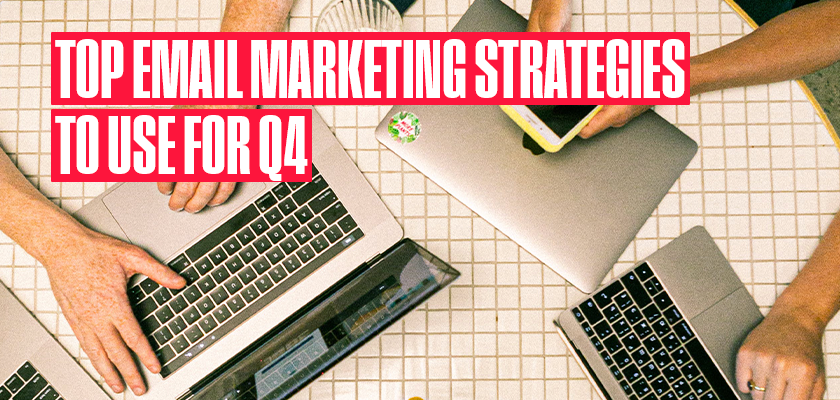
As we approach the Q4 period, it’s never too early to start preparing for your Black Friday and Cyber Monday email marketing strategy. Once Black Friday week hits, our inboxes are filled with a hurricane of brands fighting for attention, each with the ‘biggest’ and the ‘best’ offers you won’t get anywhere else.
To set your brand apart from the competition, it’s crucial to plan ahead. Over 60% of brands send out multiple emails over the course of the Black Friday/ Cyber Monday weekend, and it’s a perfect time to up your brand awareness ahead of the Christmas shopping season.
If you’re not sure where to start with Q4 planning or need some last-minute tips to enhance your strategy, we’ve outlined some top email marketing strategies to incorporate into your plans!
1. Send Pre-Black Friday Emails
Sending pre-Black Friday emails is great for keeping your brand at the forefront of people’s minds ahead of the big day. Not only will a pre-Black Friday email let your audience know about your upcoming event, but it will also ensure that your audience is regularly checking in on your brand throughout the Q4 period.
Additionally, sending pre-Black Friday emails is beneficial for A/B testing. Sending out different formats of emails with minor tweaks, such as the CTAs or subject lines, can help you determine what your audience is more likely to engage with so you can then tailor your Black Friday strategy accordingly.
2. Run a Lead Gen
It might seem like a given, but ahead of Black Friday, it’s beneficial to give your email list a much-needed boost. A simple but effective way to do this is to run a lead-generation advertising campaign. For example, offering your audience the chance to win a prize in return for submitting details, such as their email address, is a quick and easy way to increase your list size. Similarly, refreshing your pop-up on-site with an irresistible offer will also contribute to gaining new profiles.
3. Offer Something Unexpected
Email marketers only have 3 seconds to capture the attention of their readers, which isn’t surprising due to the amount of emails the average person will receive daily. If an email isn’t driving you to click on it, it swiftly gets forgotten about and lost within their inbox. Over Black Friday, to avoid this happening, make sure you’re offering something unexpected, whether that’s a mystery discount or a gift with each purchase!
One of the worst things you can do over Black Friday is to overcomplicate your promotions. If you’re offering multiple promotions and codes, things can get a bit too hectic. To make it as simple as possible, consider running a standard “up to” percentage amount. If you want to include a code, it helps to have this auto-applied at checkout to avoid customers dropping off if they input it incorrectly. In the design of your email, make sure the promotion is clearly highlighted within the design so it can’t be missed, and also referenced in the body copy and subject lines too!
5. Create An Effective Design
Creating an effective design is one thing, but how do you know what works? To improve your email campaigns, consider running an A/B test to pinpoint which elements of your design are improving the CTR and which are hindering it.
Highlighting metrics such as colour, font size, and CTAs can instantly impact whether people will click through or discard! If a consumer clicks on your email, you’ll have, on average, 11 seconds to keep their attention, so making sure your design stands out for the wave of other Black Friday content is key! Keep the design of your email reflective of your branding but with stand-out elements specifically for the shopping season.
6. Make Use Of CTAs
CTAs (call-to-action) are one of the most underrated parts of any email campaign, especially over the Black Friday period. They’re one of the driving forces behind making your email recipients turn into passive readers to customers. One key way to make your CTAs stand out is to make use of bright and bold colours that will attract and hold attention. Additionally, it’s important to think about the placement of your CTAs to increase your click-through rate, make sure the copy used is clear and concise (between two and five words) and use actionable language.
7. Focus On Subject Lines
Subject lines are make or break for every email campaign. Over Black Friday, consumers’ inboxes are cluttered with emails, so it’s important to stand out. It’s estimated that on Black Friday, 116.5 million emails from brands were sent out (more than any other day), and Black Friday sees the highest number of emails opened and clicked. To prevent your emails from being lost in the void, having a cracking subject line to stand out from competitors is everything.
The secret to a great subject line is to keep it short and snappy. On average, subject lines with 50 characters or less tend to get an average of 12% higher open rates and 75% higher click-through rates. Including emojis within subject lines has been seen to increase click-through-rates by as much as 28%!
Additionally, it helps to use language that will really pique your audience’s interest, stay away from any overused cliches and keep them as attention-grabbing as possible.
8. Prep for Cyber Monday
To plan an effective Black Friday, it’s crucial to prepare for Cyber events too. With Cyber following straight after, it’s easy to forget about it or not prioritise it as much as Black Friday, however, it’s still an extremely profitable day! To make the most of it, create dedicated campaigns and tailor your online sales messaging so that it focuses on driving urgency.
9. Incorporate SMS into Your Strategy
Sometimes the importance of SMS can be overlooked because a lot of brands assume that text messages won’t fit in with their brand. However, it’s a no-brainer for reaching even more customers. On average, 82% of people engage with marketing content on their smartphones, so it’s something to definitely explore, especially over the busy shopping period.
To gain SMS sign-ups, you can effectively tie your SMS campaign in with your lead generation and ask for customers to fill out their phone number as well as their email address. That way, they’ll be opted into your send list. It can also be used to send reminders when sales have launched or when offers are coming to a close.
Despite having only 160 characters to work with, SMS campaigns are longer than recommended email subject lines, so it can be just as, if not more effective than email marketing campaigns.
EMAIL MARKETING
Mastering Email A/B Testing for Mobile Apps: The Ultimate Guide
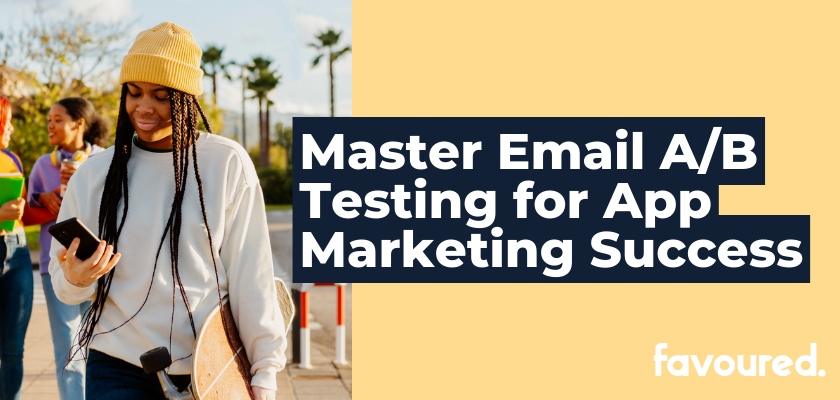
Welcome to the world of email A/B testing for mobile apps!
Here at Favoured, we’re all about delivering the best results for our clients, and that includes mastering the art of email marketing. In this guide, we’ll take you through the essentials of A/B testing your email campaigns to achieve maximum success for your mobile app.
What Is Email A/B Testing?
Email A/B testing, also known as split testing, is a method used to compare two or more variations of an email campaign to determine which one performs better. The goal is to identify the version that resonates most with your target audience, ultimately leading to higher open rates, click-through rates, and overall engagement.
In the context of mobile apps, email A/B testing can be particularly valuable, as it helps you fine-tune your marketing messages to drive user acquisition, engagement, and retention.
Benefits Of Email A/B Testing
There are numerous advantages to incorporating A/B testing into your email marketing strategy for mobile apps. Some of the key benefits include:
- Improved open rates: By testing different subject lines, you can identify which ones capture your audience’s attention and entice them to open your emails.
- Increased click-through rates: Experimenting with various email elements, such as CTAs and layout, can help you determine the most effective ways to encourage recipients to take action.
- Enhanced engagement: A/B testing allows you to create more relevant and engaging content for your target audience, resulting in higher conversion rates and stronger user relationships.
- Data-driven decision making: With A/B testing, you can make informed decisions based on actual user behaviour, rather than relying on assumptions or gut feelings.
Key Metrics To Track
When conducting email A/B tests, it’s essential to track specific metrics to gauge the success of your campaigns. Some of the most critical metrics to monitor include:
- Open rate: The percentage of recipients who open your email. This metric can help you evaluate the effectiveness of your subject lines.
- Click-through rate (CTR): The percentage of recipients who click on a link within your email. A high CTR can indicate that your email content is engaging and relevant.
- Conversion rate: The percentage of recipients who take the desired action after clicking a link in your email, such as downloading your app, making a purchase, or signing up for a newsletter.
- Unsubscribe rate: The percentage of recipients who opt out of receiving future emails from you. A high unsubscribe rate may suggest that your email content is not resonating with your audience.
Understanding the basics of email A/B testing is the first step towards optimising your mobile app marketing campaigns. By grasping the concept, benefits, and key metrics of A/B testing, you’ll be well-equipped to make data-driven decisions that drive real results for your mobile app.
Setting Up Your Test
Defining Your Goal
Before you start setting up your A/B test, it’s crucial to determine the primary objective of your test. Having a clear goal will help you focus your efforts and make data-driven decisions based on the results. Your goal should align with your overall mobile app marketing strategy and be specific, measurable, attainable, relevant, and time-bound (SMART). Examples of goals for email A/B tests include:
- Increasing the open rate by 10% within 30 days
- Boosting the click-through rate by 15% within 60 days
- Reducing the unsubscribe rate by 5% within 45 days
Selecting Variables To Test
Once you’ve set your goal, it’s time to choose the variables to test in your email campaign. The variables you select should have a direct impact on your goal and be something you can measure. Here are some common email elements to consider testing:
- Subject lines: Test different wording, phrasing, or personalisation techniques to capture your audience’s attention.
- Email content: Experiment with different content styles, lengths, or structures to see what resonates with your recipients.
- Call-to-action (CTA): Try various CTA placements, wording, or button designs to encourage users to take the desired action.
- Images and visuals: Test different images, colours, or visual layouts to determine which one drives higher engagement.
- Personalisation: Compare personalised content, such as using the recipient’s name, to generic content to assess its impact on your metrics.
Creating Variations
Now that you’ve chosen your variables, it’s time to create the variations for your email campaigns. Keep the following tips in mind when crafting your variations:
- Limit the number of variations: While it may be tempting to test multiple variations, it’s best to limit yourself to two or three, so you don’t dilute your results or prolong the testing process.
- Make distinct changes: Ensure the variations are different enough to provide meaningful insights. For instance, if testing subject lines, one could be a question, while the other could be a statement.
- Keep other elements consistent: To ensure accurate results, only change the variable you’re testing and keep all other elements the same across variations.
- Consider your audience: When creating variations, take into account your target audience’s preferences and behaviours to craft relevant and engaging content.
Setting up an A/B test for your mobile app’s email campaigns is an essential step towards optimising your marketing efforts. By defining your goal, selecting the right variables to test, and creating effective variations, you’ll be well on your way to enhancing your app’s performance and building stronger relationships with your users.
Implementing & Analysing Your Test
Test Duration & Sample Size
Determining the optimal test duration and sample size is crucial for obtaining accurate and reliable results. Here are some factors to consider when deciding on these parameters:
- Test duration: The length of your test should be long enough to gather sufficient data, but not so long that it delays your marketing efforts. Generally, a test duration of 7 to 14 days is recommended for most email A/B tests.
- Sample size: Your sample size should be large enough to provide statistically significant results. Use an A/B test sample size calculator to determine the appropriate size based on your desired confidence level and the expected difference between variations.
Keep in mind that these recommendations may vary depending on your specific circumstances, such as the size of your email list or the frequency of your email campaigns.
Launching Your Test
Once you’ve determined the test duration and sample size, it’s time to launch your A/B test. Follow these steps to ensure a smooth test launch:
- Segment your email list: Divide your email list into random, equal-sized groups to ensure a fair comparison between variations.
- Send your variations: Schedule your email campaign to send the different variations to the corresponding segments of your email list.
- Monitor the progress: Keep an eye on the key metrics, such as open rates, click-through rates, and conversion rates, throughout the test duration to ensure everything is running smoothly.
Analysing Results & Drawing Conclusions
After your test has concluded, it’s essential to analyse the data, draw conclusions, and apply your findings to future email campaigns. Here’s how to go about it:
- Review the data: Examine the key metrics for each variation and compare them to determine which one performed better.
- Check for statistical significance: Use an A/B test calculator to ensure the differences between the variations are statistically significant, indicating that the results are not due to random chance.
- Draw conclusions: Based on the data, determine what you’ve learned from the test and how it can inform your future email marketing efforts. For instance, if a specific subject line format led to higher open rates, consider using a similar approach in future campaigns.
- Apply your findings: Incorporate your learnings into your email marketing strategy to continually optimise your campaigns and drive better results for your mobile app.
Implementing and analysing your email A/B tests is a critical step towards optimising your mobile app marketing campaigns. By determining the appropriate test duration and sample size, launching your test, and analysing the results, you’ll be able to make data-driven decisions that enhance your app’s performance and foster stronger relationships with your users.
Best Practices
Consistent Testing
To achieve long-term success in email marketing for mobile apps, it’s crucial to make A/B testing a consistent part of your strategy. Regular testing allows you to:
- Continuously optimise your campaigns: Stay ahead of the curve by continually refining your email campaigns based on data-driven insights.
- Adapt to changing trends: Keep your email marketing efforts relevant and up-to-date by adapting to evolving user preferences, industry trends, and market dynamics.
- Validate new ideas: Use A/B testing to validate new marketing concepts or tactics before fully implementing them in your campaigns.
Avoiding Common Pitfalls
As with any marketing endeavour, there are potential pitfalls to watch out for when conducting email A/B tests. Here are some common mistakes and how to avoid them:
- Testing too many variables at once: Focus on testing one variable at a time to ensure accurate results and avoid confusion when analysing the data.
- Ignoring statistical significance: Make sure your test results are statistically significant to avoid drawing conclusions based on random chance or insufficient data.
- Focusing solely on short-term gains: While it’s essential to optimise for immediate results, also consider the long-term impact of your email marketing strategy on user retention and lifetime value.
Utilising Automation & Growth Hacking Strategies
Leveraging automation and growth hacking techniques can help streamline your email A/B testing efforts and drive even better results for your mobile app. Consider the following strategies:
- Email automation: Use email marketing automation tools to schedule and send your A/B tests, track key metrics, and segment your email list efficiently.
- Dynamic content: Implement dynamic content in your email campaigns to personalise messages based on user behaviour, preferences, or demographics, and A/B test the effectiveness of various personalisation techniques.
- Multivariate testing: Once you’re comfortable with A/B testing, consider using multivariate testing to assess the impact of multiple variables simultaneously and identify the best combination of elements for your campaigns.
Mastering email A/B testing for your mobile app is an ongoing process that requires consistent effort, learning, and adaptation. By following best practices, avoiding common pitfalls, and utilising automation and growth hacking strategies, you’ll be well on your way to achieving long-term success in your email marketing campaigns.
As a data-driven full-funnel marketing agency, Favoured believes in the power of optimising every aspect of the customer journey, and that includes email marketing.
We’re dedicated to helping businesses drive real results, and A/B testing plays a crucial role in this process. Reach out if you want to supercharge your email campaigns with us. Happy testing!
-

 SEARCHENGINES6 days ago
SEARCHENGINES6 days agoGoogle Core Update Volatility, Helpful Content Update Gone, Dangerous Google Search Results & Google Ads Confusion
-

 SEO6 days ago
SEO6 days ago10 Paid Search & PPC Planning Best Practices
-

 MARKETING5 days ago
MARKETING5 days ago5 Psychological Tactics to Write Better Emails
-

 MARKETING7 days ago
MARKETING7 days ago2 Ways to Take Back the Power in Your Business: Part 2
-

 SEARCHENGINES5 days ago
SEARCHENGINES5 days agoWeekend Google Core Ranking Volatility
-

 SEO6 days ago
SEO6 days agoWordPress Releases A Performance Plugin For “Near-Instant Load Times”
-

 MARKETING6 days ago
MARKETING6 days agoThe power of program management in martech
-
SEARCHENGINES4 days ago
Daily Search Forum Recap: April 15, 2024












